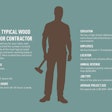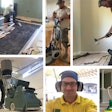
 NWFA instructors quoted here include: (back row, left to right) Brett Miller, NWFA; Jason Elquest, Blackhawk Floors, Scottsdale, Ariz.; Toby Merrill, Walk on Wood, McHenry, Ill.; Scott Taylor, Milwaukee; (second row) Jon Namba, Jon Namba Services Inc., Salt Lake City; Mike Dittmer, Michael Dittmer Wood Floors, Putnam, Ill.; Lenny Hall, Endurance Floor Company Inc., West Park, Fla.; Kjell Nymark, Metropolitan Hardwood Floors, Coquitlam, B.C.; and (kneeling) Joe Rocco, Artistic Floors by Design, Parker, Colo.
NWFA instructors quoted here include: (back row, left to right) Brett Miller, NWFA; Jason Elquest, Blackhawk Floors, Scottsdale, Ariz.; Toby Merrill, Walk on Wood, McHenry, Ill.; Scott Taylor, Milwaukee; (second row) Jon Namba, Jon Namba Services Inc., Salt Lake City; Mike Dittmer, Michael Dittmer Wood Floors, Putnam, Ill.; Lenny Hall, Endurance Floor Company Inc., West Park, Fla.; Kjell Nymark, Metropolitan Hardwood Floors, Coquitlam, B.C.; and (kneeling) Joe Rocco, Artistic Floors by Design, Parker, Colo.
Earlier this year I asked an elite group of hardwood flooring professionals—some of the National Wood Flooring Association’s regional instructors, along with NWFA Vice President of Certification and Education Brett Miller—to have a frank discussion about their view of the state of the wood flooring industry as it relates to hardwood flooring contractors and retailers. Their topics ranged from HGTV to DIYers to lowballing contractors and acclimation. With the instructors’ varied and extensive wood flooring experiences, including contracting, retailing and inspecting, they had insightful responses about today’s wood flooring market. Following are some excerpts:
Kim Wahlgren: What are some of the biggest challenges facing today’s wood flooring people out in the field?
Brett Miller: I was talking to a carpet guy out in Vegas at Surfaces and comparing industries—the carpet industry doesn’t deal with competition from overseas, and they also aren’t dealing with DIYers. In the wood flooring trade, our biggest competitor is the DIY homeowner because of liquidators and local retailers who will rent them the gun and sell them the wood. I don’t know of any other flooring industry dealing with that.
Scott Taylor: A lot of people aren’t going to do their own electrical or plumbing because they realize they have to have some sort of a permit.
Brett: If the wood flooring goes bad, they say, oh well, I’ll get carpeting. If the electrical goes bad, they’ll burn down the house!
Kjell Nymark: On the last job I sanded there was a homeowner that came over and talked to another contractor. The homeowner said, “I was thinking of getting my wood floors done, but my contractor was explaining you have to get a really good guy.” The contractor said, “You think so? Because my son watched a YouTube video and did his own floors, and they look great!”
Jon Namba: I’d love to see them!
Kjell: He thought those were great, but if I did that same job, you don’t think I’d have to redo them?!
Brett: To me, that’s a big issue in our industry. We have a labor shortage and everybody is watching HGTV and feeling like they can jump in and do it.
Kjell: Speaking of HGTV, every time you see it, they’re standing over a cupped floor—have you noticed that? They are standing there with their high-heel shoes and a cupped floor saying, “These are beautiful floors here!”
Toby Merrill: I don’t think there’s a labor shortage, there’s a qualified labor shortage. Hardwood floors are hard work; not many people want to do it. They just want to go somewhere and get a check for doing nothing.
Scott: It’s not an easy job. My dad’s a flooring retailer—he’s been in business for 40-plus years and it’s not just finding guys; it’s can they last a week? He said the biggest headache he’s had is dealing with employees—the customers are the easier part by far, if you can believe that.
Mike Dittmer: It always will be, customers are the easier part.
Scott: It’s hard on your body; they don’t really understand that. They probably do watch too much HGTV.
Kim: So where do you find good help?
 The labor shortage in the wood flooring trade was a continual theme that came up when the NWFA Regional Instructors gathered for two days. This Facebook meme (source unknown) got a huge response on HF’s Facebook wall recently.
The labor shortage in the wood flooring trade was a continual theme that came up when the NWFA Regional Instructors gathered for two days. This Facebook meme (source unknown) got a huge response on HF’s Facebook wall recently.
Joe Rocco: It’s trial and error.
Jon: You’re always searching. It’s word of mouth: “If you hear of anybody, let me know.” The last one we got was through a construction temp agency.
Jason Elquest: We get a lot of guys who say they can do something and then they really can’t perform.
Jon: The ones you have to worry about are the, “I am the best around.” Then why are you looking for work?
Lenny Hall: A lot of that, though, depends on the last place they were at, so you have to give them leeway. But it doesn’t take long …
Jason: … in about an hour on a job, you’ll know what their pay should be; whether they should go home.
Lenny: I stopped bringing them in and doing the traditional talking to them for 45 minutes. They come in, fill out an application and I send them right out to the field and say I’ll be there in a half hour.
Mike: If you get a guy who’s willing to work, then it’s your responsibility to grow that employee and make sure you pay him enough to stay but also give him skills so he’s hungry to keep learning and can grow with the company. When I sold my company we had 10 guys; we would send them to NWFA for classes and distributor classes so they would build their skills and confidence. Also, sending them to classes would build loyalty.
Jon: Getting the younger kids involved, it’s really a challenge. Their thinking processes are totally different from what we’re accustomed to.
Brett: As an industry, as business owners, how do we treat and maintain employees? [Kevin] Mullany [of Benchmark Wood Floors in Albuquerque], for example, his newest guy has been there nine years. These guys own their jobs, love working there, love what they do.
Lenny: It’s finding guys who are willing to take ownership.
Brett: It just comes from the top down, from the owner of the business down.
Lenny: Overall, for the last 25 years there is a general malaise of kids not wanting to work hard. It’s the fault of parents who baby them, walk them through every problem, never let them get a scrape. So when it comes to manual labor they have no clue. As a business owner you become the pseudo parent, the guidance counselor, the marriage counselor, the drug counselor.
Kim: What about customers? Have they changed in recent years?
Lenny: What’s changed is the customer’s perception of what a wood floor is, and that’s from the marketing of the big players in the industry …
Scott: … a 50 year warranty …
Lenny: … they have touted that the prefinished, the engineered floor is the way to go. For some clients, they think engineered is the sliced bread of wood flooring; it will take care of everything.
RELATED: Engineered 101: Understand the Fundamentals of Engineered Wood Flooring
Jason: Well, that’s HGTV; that’s exactly what they tout on there. You install this engineered floor and everything’s good …
Lenny: You have this massive marketing of prefinished and engineered product—that have their place in the world—but it’s pushing out the craftsmen in the industry. You don’t have to be a craftsman to do that stuff.
Kjell: That’s exactly right.
Lenny: All you’ve got to do is have a credit card, buy 15 boxes, buy a trowel, buy glue …
Kjell: … you’re lucky if they are gluing it, because it’s too expensive for them to buy glue.
Scott: I was on an inspection a couple months ago—this woman was suing the manufacturer; she was upset the floor made noise. She had turned off the humidifier and had a grown son in a wheel chair; in total he and his chair were 650 pounds. She would not take any blame; she wanted them to replace all the flooring.
Jason: That’s the same problem I see with employees; no one wants to take ownership of an issue. Last year we had a big engineered job; everyone thought somebody else checked the subfloor flatness. So we installed the floor and there was a huge valley. I told her the complaint was totally legitimate and we would fix it, but she was ready to sue me. I had formal letters from her attorney. It cost me about $37,000 to fix that floor when you figure man hours, and at that point I’m fixing every single little thing because I want to make her happy …
Lenny: … because each time you go there she’s looking and looking …
Jason: … the whole reason it got that bad was—she told me afterwards—no one had ever taken ownership of a problem they have caused for her. Even my employee who didn’t check the subfloor said, “She is a giant pain; I can’t believe she’s making us do this!” At least at some point say, “Boss, I screwed up.”
Kim: What else is going on with slab prep?
 No matter what area of the United States or Canada they are in, NWFA Regional Instructors agreed that wood floors in gray and white tones are all the rage with today’s consumers.
No matter what area of the United States or Canada they are in, NWFA Regional Instructors agreed that wood floors in gray and white tones are all the rage with today’s consumers.
Lenny: Concrete can have rapid driers, bond releasers … I had a job where we replaced the existing flooring; it was ⅜-inch engineered and had what looked like pitcher’s mounds all over. I peeled some pieces back and the glue was smooth as glass on the bottom of the boards; there was nothing on the concrete. I poured some water on the slab and it beaded up just like on the hood of your car.
Mike: Some manufacturers will recommend to do a sample of the adhesive or system on the job a week or two before just to be sure it adheres properly …
Jon: … but doing a bond test is not a sure indication. That glue will be aggressive for that short period of time but as that adhesive cures, that’s when you see the movement occur. Part of the problem, too, is you’re seeing the cement industry changing their formulations. They are starting to use fly ash, and that’s affecting the bonding of the adhesive. But does that side of the industry communicate with the flooring industry? No.
Jason: I’m in a 99 percent slab market and we deal with that every single day—bond issues. CSP—concrete surface profile—is everything. Your glue will stick if you have it profiled properly.
Lenny: We don’t do bond tests anymore. We end up scarifying if it doesn’t have penetration of water. We sprinkle water and if it sinks in, we’ve got penetration.
Jon: So what you’re doing first is a porosity test …
Brett: I think the bad part of that is that there’s no real test method to determine it—you’re pouring water on …
RELATED: Step by Step: How to Get a Concrete Slab Ready for Wood Floors
Jon: … and now you have a hardwood floor installer who all of a sudden is having to invest in concrete surface preparation tools. We’ve invested in a concrete grinder.
Jason: We have giant change orders due to concrete prep. You’ve got them a little bit under the gun: You’ve demo’d their flooring, they’ve given you a giant deposit, you’ve got all their materials sitting there on site and now you’re hitting them the day of install with an additional amount; it could be as little as $800, or we just had a change order for $18,000 for subfloor prep.
Jon: Last week we had a $1,900 change order for subfloor prep that was on 500 square feet …
Jason: … and that’s expensive when people weren’t planning to spend it.
Kjell: You know what happens to that, too, when the price gets that high on a small job? The contractor says I’ll make it cheaper for them and he only does half the prep he should have. Then if that job ends up in failure, the contractor tried to do them a favor and you feel bad for him, but if you’re going to take on a job, you’ve got to do the whole thing properly.
Scott: Or some people just go to carpet …
Jason: … I had that happen once. They couldn’t afford it, and I get it. Can you imagine you’ve got this money set aside to spend $20,000 and we hit them with another four grand? They don’t have the money, so they say, “We’ll go back to carpet for a few more years.” It’s another black eye on the industry.
Lenny: It shouldn’t be a black eye; it isn’t our fault …
Jason: … but it’s that perception …
Jon: … when they have to settle for something else.
Kim: What about preparing the job site as far as acclimation?
Scott: I know a guy in Chicago with a humidor in his warehouse. Someone on the job site sends in what the humidity is at the job site and the guy in the warehouse adjusts the warehouse to make sure the wood will be right for the RH at the job.
Jason: We have a dry room we put material into so it can acclimate. Sometimes the house is ready but there is no place to secure that product—there are too many other trades, and somebody might take it. So we can go straight from the dry room to the job site and can install that day because we know it has acclimated.
Lenny: It’s when the moisture meter says it’s ready.
Kjell: People have the misconception that with engineered product they don’t need to.
Kim: Some engineered manufacturers don’t recommend it …
Kjell: … but the environment has to be acclimated to the material.
Scott: People say, “We did it for 72 hours.” I say, “Great, what was the RH at the time you installed it?” They say, “How I am I supposed to know? I had it in here 72 hours!” It isn’t 72 hours; it’s based on the environment.
RELATED: Understanding How to Measure Moisture Can Avert Job-Site Disasters
Jason: So what do we do in regions like Arizona, New Mexico, part of Southern California, Nevada, Utah, where the humidity is below that 30 percent? What do we do as an industry? With distributors whose product is in my showroom, I have them sign saying that if their product is in my showroom they will warranty my installation for relative humidity, whether it be low or high. If you are going to sell a product and make a profit in this region, you need to warranty it for this region’s RH …
Brett: The difficulty with that is people are buying product over the Internet, buying it at big boxes—it’s not controllable by the manufacturer.
Jason: It’s controllable by a large portion of them if they have a distributor here …
Brett: … the wood distributor, but not the big boxes and buying groups—that’s where people are shopping and that’s where people are being misinformed on the products they’re buying, which is what is damaging the name for wood flooring.
 "CSP—concrete surface profile—is everything. Your glue will stick if you have it profiled properly."— Jason Elquest |
Scott: There’s a mill out West that dries all their product to 5 percent and they asked if I would sell in the Midwest. I said that’s not going to fly, and they said, “Don’t worry, we’ll dry to those moisture conditions.” I said, “OK, here’s a scenario. You’ve got an 8-inch plank and the guy needs 300 more feet at the last minute. What are you going to do? You have it in stock, but it’s the 5 percent stuff. It will blow up and the tongues aren’t going to fit together.” That’s something that is a huge struggle; I think Jason makes a good point.
Brett: It is a good point, but easier said than done. Homeowners aren’t buying from a wood floor guy anymore, so they go to the big places and the buying groups are buying stuff they know that sells.
Jason: As an inspector I go in there, and I have to fail it, and it goes back to job site conditions …
Brett: … and back to the homeowner for conditions …
Jason: … or the installer for installing that product in a hostile environment …
Brett: … and that’s what damages the industry …
Jason: … and it’s all on the installer.
Scott: I did training for a distributor in Salt Lake City. I had my hygrometer on the desk and it never went above 20 percent. So I asked the sales guys, “How do you sell here?” They said, “We just tell everyone they have to have their environment at 30 to 35 percent.” I said, “When there is a claim, how does it get addressed? I’ve been here all day and it’s never achieved 20 percent; you know how many inspections I’ve been on where floors have failed at 20 percent?!”
Brett: I think a lot of it goes back to products that are out now. Floors have been installed successfully in Arizona and New Mexico and Utah for years. It isn’t that the products have gotten worse; the products have changed. They are different than they were, and the homes where these floors are being installed are different.
Jon: It’s the education of the end user of what they have to do to control their environment.
Kjell: Well, right now how are they buying it? Color and cost, those are the two parameters they are looking at …
RELATED: How Many Wood Floor 'Failures' Start Before the Sale
Jason: … and that’s probably exactly it, and it’s in that order, too.
Kjell: You can get the same color in any kind of material. They say, “That one looks like that one to me, but that is two dollars cheaper”…
Mike: That’s the one they’re going to buy.
Kjell: Bingo, there’s the one. It doesn’t necessarily work in your environment, but that’s the one they want …
 "I think they’ll have to get smarter as far as business practices in order to compete in this changing market."— Jon Namba |
Lenny: … and it looks great on the rack …
Scott: … and they like the color, say it’s brown—they don’t care that one is walnut and one is ipé. “I’ll have that, and then I’ll complain that my heels dent the floor.” Well, it’s walnut!
Lenny: I went to an engineered inspection. It was a product with a skin veneer of Brazilian walnut on a softwood core, like poplar, and it was pockmarked with dents. The homeowners said, “They told me this was the hardest wood ever.” I said, “Look, those tests are for solid lumber materials. Your Brazilian walnut is standing on top of a sponge cake.” She was pissed off that the people who sold her that floor didn’t tell her that.
Jon: Yup, they said cumaru is so hard …
Lenny: … but it wasn’t even the distributor or the dealer, it was the manufacturer. Have you seen how many brochures say the floor has a Janka hardness of 3,180, but it’s an engineered floor with a 1.5-millimeter wear layer?
Jason: It’s hard on the outside and soft in the middle.
Kim: Going back to color, let’s talk about consumer preferences.
Lenny: Everything is gray-white …
Mike: …and dark black.
Toby: It’s shifting to gray-white, wider plank, less exotics, more domestics. We’ve been doing very little exotic flooring. There was a time with Brazilian cherry through the mid-2000s when the market was flooded with millions and millions of square feet of Brazilian cherry and it was cheaper than oak in our market. You could get it for $1.90 a square foot and now it’s $5.50 a foot.
Lenny: Now it’s normalized.
Toby: We’re doing rift and quartered red and white oak and we’ve been doing a bunch of hickory lately. It’s definitely wider plank and only getting wider. Four-inch was all the rage a couple years ago, now it’s going to 5, 6, they’re talking about 8-inch.
Jason: I’ve got 18-inch engineered a rep just brought in for me. It’s a 5-mil wear layer, ¾-inch floor.
 "That’s how they think—as long as I’m working every day, I have to be making money."— Kjell Nymark |
Lenny: I had a job 1¼ thick and 19½ inches wide.
Toby: [Chris] Zizza [of C&R Flooring in Westwood, Mass.] got some that was 40 feet long.
Lenny: Mine came in at 232 inches. It had to go wall-to-wall with no joints in the house. It was the craziest thing ever; we had to put the floor in before the drywall. I said, “I’m testing it now and testing every two weeks; you’ve gotta maintain that AC unit and keep doors closed.” It took four guys to install one plank—you’ve got a 19-inch spread of glue and then slip tongue because it didn’t have a male and female.
Kim: What about different products like stains and dyes?
Lenny: There’s iron acetate and ammonia and a bunch of things you can do, but it’s whatever makes the floor that weathered driftwood grayish kind of color.
RELATED: Shades of Gray: How to Use Vinegar & Steel Wool to Darken a Floor
Jon: That’s what people want.
Lenny: They see it in the magazine, and I get that email: I saw this; can I get it?
Kjell: How much has Pinterest influenced that?
Jon: Pinterest, Houzz …
Jason: Houzz is the biggest thing that I see. “French oak,” “European oak,”—they are just buzzwords …
Lenny: … they get white oak but it’s not really going to be coming from France.
Jason: It’s coming from the Russian-Chinese border.
Toby: Siberian oak is what I call it …
Jon: Another challenge is the oil finishes that are being introduced to the market; we haven’t really done a good job of addressing the maintenance to the consumer.
Lenny: That hexagon floor I did—at the time I gave the lady a 2-liter bottle of floor soap and I told her she had to use it every week. I went back a year later and the floor was so dirty. I asked for the soap; they looked in the back of the garage and it was still full—a full year went by on an oil-only end-grain floor.
Kjell: If they maintain it, it will last forever, but they wait too long for maintenance, and now you have to start over again.
Mike: I’ve got a customer in an $8 million house and we’re going to resand her oil-and-wax hand-scraped walnut floors and put a hard finish on them because she’s got five dogs; the cleaning lady can’t take care of maintaining the floors and she doesn’t want me to come up all the time. The floors are 8 years old and they’re destroyed.
Jon: Getting the customer educated to do that maintenance is tough.
Kim: Going forward, what do contractors need to do to be successful?
Jon: I think they’ll have to get smarter as far as business practices in order to compete in this changing market and they will have to sharpen their technical skills …
Kjell: … and buy some equipment! You’ve gotta see what I’ve been seeing! Man, it’s awful …
Jon: … what guys will make do to get the job done.
Kjell: It’s just horrendous. If I’m a homeowner and I’m seeing Hobo Joe unloading his truck with this stuff, I wouldn’t let him open the door.
Jon: It’s a part of business—they need to learn how to invest back into the business.
Kjell: They’re competing for the bottom dollar; that’s what drives me nuts. Why aren’t you gluing down the product? Adhesive costs money? Are you kidding me? It’s not like they’re buying the adhesive to do the job; you’re supposed to sell that as part of the job, but they don’t get it.
Joe: I think Kjell hit on something I see a lot: People want to buy a $1.50 product, but they want the guy to show up in a brand-new van and clean and all this stuff—those ideas are diametrically opposed. Their expectations are way up here but they only want to buy something down here. For the young guys, if I had to say something, it’s just be honest and up front: This is what I provide, if that meets your expectations, great, I’d love to work for you and if not you can find someone …
Jon: They’re too scared to do that.
Joe: “Hobo Joe” down the road; he’ll do it for cheaper.
Scott: One of the distributors in our area said 60–70 percent of their dealers don’t even have a moisture meter. I did an inspection where end joints opened up on an engineered floor. I asked him if he tested the moisture of the product before he installed it. He said, “I know where you are going with this. I don’t have a moisture meter, and if you’re going to find I am responsible for this, I’m not buying any more product from [that company].” I said, “You know what, I think it’s in your best interest to have a moisture meter. I know you’ve been doing it 20 years; are you telling me this is the only time this has come back to haunt you?” Because that’s the most ridiculous thing I’ve ever heard.
Lenny: It’s a bad state of mind for a lot of contractors—to live and work job by job without looking to the future …
Mike: … and a lot of contractors do it that way. None of my competitors have dust containment. For three to six thousand dollars you can get a decent dust containment unit so it’s healthier for you and your employees and healthier and cleaner for your customers. You aren’t charging enough to afford this?!
Lenny: They don’t charge anywhere near enough.
Mike: You can do a much better job.
Lenny: But it’s true; they don’t invest in themselves.
Kjell: If you ask a guy at a distributor: “How are you doing?” “Oh, I’m so busy, I’m three, four weeks out.” They are all saying the same thing; they are all busy but they’re not making any money. But that’s how they think—as long as I’m working every day I have to be making money …
Mike: … and that’s the bottom line; you’re in it to make money. I scaled from nine guys to me and a helper. I’ve taken an income hit, but I’ve been incrementally bringing up the level and the scale of the work that I do so I can charge more so I can make up for that. So if I need a new tool I can afford it.
Lenny: Any time you can buy a tool that can solve a problem on a job site by 20, 30 or 50 percent of labor, you buy the tool, because that tool pays for itself in one or two jobs and you have 100 jobs after that where you can use it, but these guys won’t spend the money.































